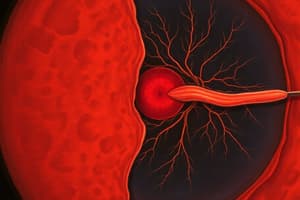Podcast
Questions and Answers
What is the main function of Interstitial retinoid binding protein (IRBP) in the process of regeneration of bleached photopigment?
What is the main function of Interstitial retinoid binding protein (IRBP) in the process of regeneration of bleached photopigment?
- It catalyzes the conversion of trans-retinal to 11-cis-retinal
- It transports 11-cis-retinal back to the photoreceptor
- It stores vitamin A for the regeneration process
- It chaperones transretinal from the photoreceptor to the RPE (correct)
What is the role of RPE65 in the regeneration of bleached photopigment?
What is the role of RPE65 in the regeneration of bleached photopigment?
- It phagocytoses old photoreceptor discs
- It catalyzes the shedding of old photoreceptor discs
- It transports 11-cis-retinal back to the photoreceptor
- It is involved in the conversion of trans- to 11-cis-retinal in the RPE (correct)
What is the function of shedding and renewal of photoreceptor discs?
What is the function of shedding and renewal of photoreceptor discs?
- To store vitamin A for photopigment regeneration
- To facilitate the transport of 11-cis-retinal to the photoreceptor
- To continuously remove old discs and replace them with new ones (correct)
- To maintain the structural integrity of the RPE
What is the impact of a separation between the RPE and photoreceptors on photoreceptor health?
What is the impact of a separation between the RPE and photoreceptors on photoreceptor health?
What is the primary function of the interface between the RPE and photoreceptors?
What is the primary function of the interface between the RPE and photoreceptors?
Which cells become active in the retina when infection is present or injury has occurred?
Which cells become active in the retina when infection is present or injury has occurred?
What is the primary function of astrocytes in the retina?
What is the primary function of astrocytes in the retina?
Which cells modify the neural signal before it leaves via the optic nerve?
Which cells modify the neural signal before it leaves via the optic nerve?
What is the direction of information flow in the retina?
What is the direction of information flow in the retina?
What is the target of light in the retina?
What is the target of light in the retina?
Flashcards are hidden until you start studying
Study Notes
Retinal Pigment Epithelium (RPE) Functions
- Absorbs scattered light to enhance visual acuity.
- Provides physical support for photoreceptors, helping maintain their structure.
- Facilitates the trafficking of nutrients from the choroid to the outer retina.
- Participates in the renewal of photoreceptor discs, ensuring their functionality.
- Regenerates photopigments, crucial for visual signal transduction.
Properties of the RPE
- Composed of a single layer of pigmented cells that are the outermost retinal layer.
- Contains melanosomes, which are responsible for pigmentation.
- Strongly attached to the choroid, featuring numerous infoldings at the basal aspect.
- Faces the neural retina at the apical aspect, extending microvilli to interact with photoreceptors.
- Tight junctions create the blood-retinal barrier near the apical surface, protecting retinal integrity.
Interphotoreceptor Matrix (IPM)
- Occupies the space between RPE processes and photoreceptors, not allowing direct attachment.
- Composed of proteins and glycosaminoglycans, facilitating the attachment of RPE to photoreceptors.
- Enables the exchange of metabolites, crucial for cellular function and health.
Retinal Structure and Organization
- Retina consists of ten distinct layers, with a functional organization that supports vision.
- Outer retinal layers include: RPE, photoreceptors, external limiting membrane, outer nuclear layer, and outer plexiform layer.
- Inner retinal layers include: inner nuclear layer, inner plexiform layer, ganglion cell layer, nerve fibre layer, and internal limiting membrane.
Cells in the Retinal Layers
- Retinal layers house various cell types including:
- RPE cells: Support photoreceptors.
- Photoreceptors: Comprise rods and cones, responsible for light detection.
- Bipolar cells: Relay signals between photoreceptors and ganglion cells.
- Horizontal cells: Integrate signals across photoreceptors and bipolar cells.
- Amacrine cells: Mediate signal processing within the inner retina.
- Interplexiform neurons: Connect different retinal layers.
- Ganglion cells: Send visual information to the brain.
Neuroglial Cells in the Retina
- Support cells in the retina that do not transmit neural signals but provide structural integrity.
- Subtypes include:
- Müller cells: Extend throughout the retina and contribute to its architecture.
- Microglia: Involved in immune responses within retinal tissue.
- Astrocytes: Provide support and maintain the environment for retinal neurons.
Studying That Suits You
Use AI to generate personalized quizzes and flashcards to suit your learning preferences.




